ARTEC ROBO 1.0

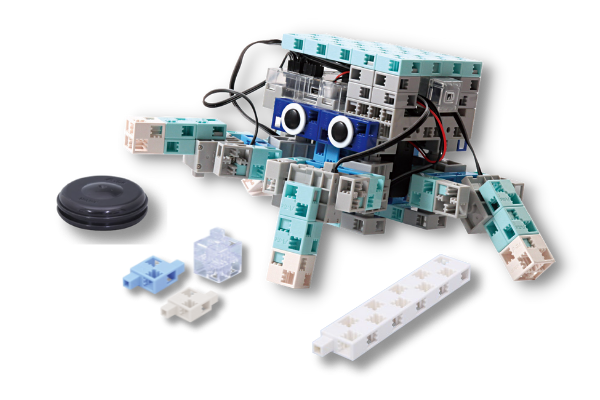
Kits
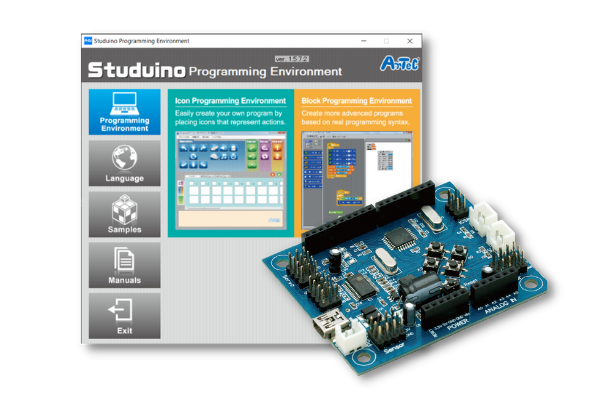
Software
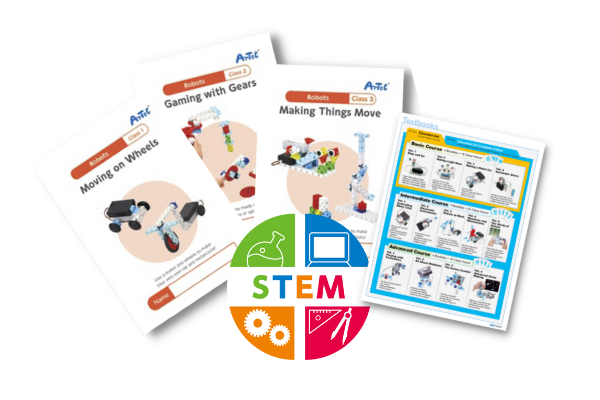
Teaching material
Robotics and Programming Kits
Basic, Advanced, Early Education Set, Education Set

Start your journey into robotics with the Artec Robô Basic! This kit is the perfect choice for those who want to explore robotics and programming in a practical and fun way. With modular blocks, motors, sensors, and LEDs, the Artec Robô Basic allows you to create interactive robots such as pets, line followers, and even industrial robots! The intuitive programming platform lets students learn how to program visually by dragging and connecting blocks. Perfect for beginners and those looking to expand their robotics skills.
Box Content
- 1 Studuino with mounting base and cover
- 1 Battery box with cable
- 1 USB cable
- 1 Sensor connection cable (4 wires, 50 cm)
- 2 Sensor connection cables (3 wires, 30 cm)
- 8 Sensor connection cables (3 wires, 15 cm)
- 2 DC motors
- 3 Servo motors
- 4 LEDs (red, green, white, blue)
- 1 Buzzer
- 2 IR light sensors
- 1 Sound sensor
- 1 Light sensor
- 1 Touch sensor
- 1 Accelerometer
- 10 Basic cubes (white)
- 4 Basic cubes (transparent)
- 4 Triangular A blocks (gray)
- 2 Triangular A blocks (transparent)
- 2 Half A blocks (light gray)
- 10 Half B blocks (blue)
- 40 Half C blocks (light aqua)
- 30 Half D blocks (aqua)
- 8 Axles C
- 4 Rubber rings
- 4 Wheels
- 2 Discs
- 1 Block remover
System Requirements:
- Operating System: Windows XP SP3 / Vista / 7 / 8 / 8.1 / 10 (32/64 bit), Mac OS X 10.6 or later.
- Hardware Requirements: Pentium 4 CPU, 2 GHz or higher, 256 MB RAM, USB 2.0, minimum XGA resolution (1024 × 768).
- Software Requirements: Microsoft .NET Framework 4.5 (automatically installed).
- Arduino Compatibility: The Studuino is compatible with the Arduino platform, allowing students to learn and apply the C programming language, enhancing their skills as they progress.
Educational Applications:
- Programming Skill Development: Ideal for programming beginners, the kit offers an accessible way to learn logic and system control.
- Robot Construction: Enables the creation of interactive robots for various purposes, such as movement, object detection, sensors, and environmental interaction.
Sensor and Motor - Exploration: Teaches the use of sensors (such as IR, sound, light, and touch) and motors to build robots that respond to their environment.
Educational Materials: The Artec Robô Basic comes with assembly instructions to build various types of robots, promoting hands-on learning of mechanics and programming:
- Car robot with arm
- Dog robot
- Line follower
- Sensor-controlled robot
- Transporter
Programming Platform: The kit includes a simple and intuitive programming platform, allowing students to program robots using the drag-and-drop methodology, ideal for beginners.
Icon-Based Programming Environment:
A fun and colorful interface to program robots with blocks, representing actual programming syntax.
Block-Based Programming Environment:
A customized version of MIT Scratch, designed specifically for robot programming, helping students understand programming logic without directly writing code.
Arduino IDE Environment:
For advanced users, the Arduino IDE provides a deeper level of programming using C language, allowing for more specific adjustments to projects.
Studuino Technical Features:
- Dimensions: 70 x 60 x 10 mm
- Microcontroller (MCU): ATmega168PA
- Digital Input/Output Pins: 14 pins (DC motor control: D2, D3, D4, D5, D7, D8; Servo motor control: D2, D4, D7, D8, D9, D10, D11, D12)
- Analog Input Pins: 8 (A0 to A7)
- Clock Speed: 8 MHz
- Operating Voltage: 3.3V
- DC Motor Driver: TB6552FNG (max. 1A)
- USB Serial IC: PL2303TA
Learning Benefits:
- Development of logical reasoning and computational thinking.
- Encouragement of hands-on experimentation in robotics and engineering.
- Progressive learning through an intuitive interface and visual programming features.

Box Content
- 1 Studuino with mounting base and cover
- 1 Battery box with cable
- 1 USB cable
- 1 Sensor connection cable (4 wires, 50 cm)
- 2 Sensor connection cables (3 wires, 30 cm)
- 8 Sensor connection cables (3 wires, 15 cm)
- 2 Servo motor extension cables
- 2 DC motors
- 8 Servo motors
- 4 LEDs (red, green, white, blue)
- 1 Buzzer
- 2 IR light sensors
- 1 Sound sensor
- 1 Light sensor
- 1 Touch sensor
- 1 Accelerometer
- 20 Basic cubes (white)
- 4 Basic cubes (transparent)
- 8 Triangular A blocks (gray)
- 2 Triangular A blocks (transparent)
- 11 Half A blocks (light gray)
- 12 Half B blocks (blue)
- 54 Half C blocks (light aqua)
- 30 Half D blocks (aqua)
- 8 Axles
- 4 Rubber rings
- 4 Wheels
- 2 Discs
- 1 Block remover
Educational Applications:
- Visual Robot Programming: Ideal for robotics and programming students who want to learn in a fun, hands-on way using a graphical interface to control robots.
- Interactive Robot Creation: Build advanced robots like line followers, sensor-controlled robots, and much more.
- Sensor and Actuation Exploration: With advanced sensors and the ability to control multiple servo motors, students can experiment with different actions and interactions between robots and their environment.
Educational Materials: The Artec Robô Advanced comes with detailed instructions for creating more complex robotic projects, exploring different types of mechanisms and sensors:
- Car robot with arm
- Advanced robot
- Advanced line follower
- Sensor-controlled robot
Programming Platform: The kit uses the Studuino platform, enabling intuitive and easy-to-understand visual programming of robots. The drag-and-drop interface makes learning programming simple without the need to write complicated code, but also allows for a smooth transition to more advanced programming environments.
Icon-Based Programming Environment:
A colorful, fun interface for learning robot programming.
Block-Based Programming Environment:
Based on the Scratch platform, this environment lets students learn programming concepts in a fun and practical way.
Arduino IDE Environment:
For more advanced students, the Arduino IDE provides the opportunity to program directly in C, offering deeper understanding of technical concepts.
Studuino Technical Features:
● Dimensions: 70 x 60 x 10 mm
● Microcontroller (MCU): ATmega168PA
● Digital Input/Output Pins: 14 pins (DC motor control: D2, D3, D4, D5, D7, D8; Servo motor control: D2, D4, D7, D8, D9, D10, D11, D12)
● Analog Input Pins: 8 (A0 to A7)
● Clock Speed: 8 MHz
● Operating Voltage: 3.3V
● DC Motor Driver: TB6552FNG (max. 1A)
● USB Serial IC: PL2303TA
System Requirements:
- Operating System: Windows XP SP3 / Vista / 7 / 8 / 8.1 / 10 (32/64 bit), Mac OS X 10.6 or later
- Hardware Requirements: Pentium 4 CPU, 2 GHz or higher, 256 MB RAM, USB 2.0, minimum XGA resolution (1024 × 768)
- Software Requirements: Microsoft .NET Framework 4.5 (automatically installed)
Arduino Compatibility: The Studuino is fully compatible with the Arduino platform, allowing students to deepen their knowledge of programming, using C language to control robot components. This allows for the creation of customized programs and the use of additional libraries to expand project functionality.
Learning Benefits:
- Programming Skills Development: Learn fundamental programming and hardware control concepts in a fun and accessible way.
- Hands-On Robotics Exploration: Build and program real robots with different levels of complexity, learning to integrate electronic and mechanical components.
- Gradual Learning: The Studuino platform facilitates learning with different difficulty levels, from beginners to advanced users.

Box Content
- 1 Studuino with mounting base and cover
- 1 Battery box with cable
- 1 USB cable
- 3 Sensor connection cables (3 wires)
- 2 DC motors
- 2 LEDs (red, blue)
- 1 Buzzer
- 18 Basic cubes (aqua, white, red, yellow, yellow-green)
- 10 Triangular A blocks (red, aqua, yellow)
- 4 Half A blocks (light gray)
- 5 Half B blocks (blue)
- 8 Half C blocks (light aqua)
- 5 Half D blocks (aqua)
- 4 Beams
- 5 Axles C
- 4 Rubber rings
- 4 Wheels
- 4 Discs
- 2 Tires
- 2 Gears (L)
- 4 Gears (S)
- 2 Gear tracks
- 1 Base
- 1 Block remover
Educational Applications:
- Introduction to Robotics for Kids: Ideal for teaching children about robotics in an accessible way, stimulating problem-solving and creativity while building simple robots.
- Basic Programming Education: With visual programming based on icons, children will learn programming logic, motor control, and sensors in a fun and uncomplicated way.
- Cognitive Skill Development: By building and programming robots, children develop logical thinking, motor coordination, and creativity.
- Interactive and Fun Teaching: Lessons based on practical activities reinforce learned concepts, allowing children to see how components interact and function in real-life applications.
Learning Benefits:
- Easy to Use: The visual interface makes programming simple for beginners, with no need to type code.
- Fun and Educational: Playful activities combined with technical learning make the experience enjoyable and engaging.
- Stimulates Creativity: By creating robots and programming actions, children can explore their ideas and solutions to various challenges.
- Progressive Learning: The kit offers activities of varying difficulty levels, allowing children to advance as they acquire new skills.
Educational Materials: The Artec Early Education Set includes educational content divided into two main parts: Robotics and Programming. Lessons are divided into 6 lessons per subject, each designed to teach concepts progressively and in a fun way. The kit comes with illustrated books that guide children step-by-step.
Robotics Lessons:
- Lesson 1: Building a vehicle with motor and wheels
- Lesson 2: Using gears to pick up blocks
- Lesson 3: Using mechanisms for movement
Programming Lessons:
- Lesson 1: Programming a car to drive
- Lesson 2: Using motors to make a car turn
- Lesson 3: Programming sound and light
Programming Platform: The Artec Early Education Set uses the Studuino platform, designed to be intuitive and easy to use. Programming is done through a graphical interface based on icons, allowing children to visually and playfully build their programs. This block-based programming environment is ideal for beginners to learn about programming logic, making the learning process simple and engaging.
Studuino Technical Features:
- Dimensions: 70 x 60 x 10 mm
- Microcontroller (MCU): ATmega168PA
- Digital Input/Output Pins: 14 pins (DC motor control: D2, D3, D4, D5, D7, D8; Servo motor control: D2, D4, D7, D8, D9, D10, D11, D12)
- Analog Input Pins: 8 (A0 to A7)
- Clock Speed: 8 MHz
- Operating Voltage: 3.3V
- DC Motor Driver: TB6552FNG (max. 1A)
- USB Serial IC: PL2303TA
System Requirements:
- Operating System: Windows XP SP3 / Vista / 7 / 8 / 8.1 / 10 (32/64 bit), Mac OS X 10.6 or later
- Hardware Requirements: Pentium 4 CPU, 2 GHz or higher, 256 MB RAM, USB 2.0, minimum XGA resolution (1024 × 768)
- Software Requirements: Microsoft .NET Framework 4.5 (automatically installed)
Arduino Compatibility: While the focus of the Artec Early Education Set is on visual and playful learning, the Studuino platform is also compatible with the Arduino language, allowing children to progress to more complex programming concepts as they gain confidence in their skills.
Educational Applications:
- Introduction to Robotics for Kids: Ideal for teaching children about robotics in an accessible way, stimulating problem-solving and creativity while building simple robots.
- Basic Programming Education: With visual programming based on icons, children will learn programming logic, motor control, and sensors in a fun and uncomplicated way.
- Cognitive Skill Development: By building and programming robots, children develop logical thinking, motor coordination, and creativity.
- Interactive and Fun Teaching: Lessons based on practical activities reinforce learned concepts, allowing children to see how components interact and function in real-life applications.
Learning Benefits:
- Easy to Use: The visual interface makes programming simple for beginners, with no need to type code.
- Fun and Educational: Playful activities combined with technical learning make the experience enjoyable and engaging.
- Stimulates Creativity: By creating robots and programming actions, children can explore their ideas and solutions to various challenges.
- Progressive Learning: The kit offers activities of varying difficulty levels, allowing children to advance as they acquire new skills.

El Kit Educativo es un kit diseñado para que las escuelas enseñen/aprendan los fundamentos de la programación con diferentes sensores y actuadores. Este kit incluye no solo piezas de robot, sino también libros de texto para estudiantes y una guía paso a paso para que los profesores aprendan los fundamentos de la programación.
Si tu país/escuela ha comenzado a enseñar programación y estás buscando materiales de programación de robots, ¡este es el kit perfecto para ti!
Box Content
- 1 Studuino with base mount and cover
- 1 Battery box with cable
- 1 USB cable
- 5 Sensor connecting cables (3-wire)
- 1 DC motor
- 1 Servomotor
- 3 LEDs (red, blue, green)
- 1 Buzzer
- 1 IR Photoreflector
- 1 Light sensor
- 1 Sound sensor
- 1 Touch sensor
- 18 Basic cube (white)
- 2 Triangle A (gray)
- 2 Half A (light gray)
- 1 Half B (blue)
- 5 Half C (light aqua)
- 4 Half D (aqua)
- 2 Beams
- 2 O-rings
- 3 Wheels
- 1 Block remover
Educational Materials: The Artec Education Set includes a complete, structured educational package, perfect for robotics classes in schools. The educational material consists of 4 books, each with 4 lessons designed to teach students both basic and advanced concepts in robotics and programming.
Basic Course (16 hours of learning):
- Basic 1 (4 lessons): Building a Traffic Light
Introduction to LED and sensor control, creating a traffic light with simple programming. - Basic 2 (4 lessons): Creating a Light Show
Creative use of LEDs and programming to create light effects, exploring control and timing concepts. - Basic 3 (4 lessons): Building a Robot Car
Construction of a basic robot car using DC motors, servo motors, and sensors, with programming to control movement and interactivity. - Basic 4 (4 lessons): Building an Automatic Door
Design and construction of an automatic door with touch sensors and programming for automatic opening and closing.
Teacher’s Manual: The kit includes a teacher’s manual with detailed guides to help implement lessons effectively. The manual provides instructions on how to teach each lesson, along with suggestions for additional activities and solutions to common challenges.
Programming Platform: The Artec Education Set uses the Studuino platform, ideal for beginners in programming. The programming interface is block-based and icon-driven, allowing students to assemble their programs intuitively, without needing to type any code. The use of Studuino facilitates understanding programming concepts, making the learning process more interactive and accessible.
Studuino Technical Features:
- Dimensions: 70 x 60 x 10 mm
- Microcontroller (MCU): ATmega168PA
- Digital Input/Output Pins: 14 pins (motor control, LEDs, etc.)
- Analog Input Pins: 8 pins (A0 to A7)
- Clock Speed: 8 MHz
- Operating Voltage: 3.3V
- DC Motor Driver: TB6552FNG (max. 1A)
- USB Serial IC: PL2303TA
System Requirements:
- Operating System: Windows XP SP3 / Vista / 7 / 8 / 8.1 / 10 (32/64 bit), Mac OS X 10.6 or later
- Hardware Requirements: Pentium 4 CPU, 2 GHz or higher, 256 MB RAM, USB 2.0, minimum XGA resolution (1024 × 768)
- Software Requirements: Microsoft .NET Framework 4.5 (automatically installed with Studuino software)
Arduino Compatibility: While the Artec Education Set primarily uses the visual interface for programming, Studuino is also compatible with Arduino, allowing students to progress to C programming as their skills develop.
Educational Applications:
- Introduction to Robotics and Programming: The kit is perfect for schools that want to offer a structured curriculum for beginners in robotics and programming.
- Technical Skills Development: By building and programming robots, students develop technical skills in engineering, programming, problem-solving, and computational logic.
- Interactive and Progressive Teaching: The lessons are designed to evolve from simple concepts to more complex ones, with hands-on activities that reinforce learning.
- Teacher Support: The teacher’s manual provides complete support for lesson implementation and makes teaching more efficient.
Learning Benefits:
- Structured Learning: With well-organized educational content, the kit offers a clear progression for learning robotics and programming.
- Accessible and Intuitive: The Studuino platform enables even beginners to quickly understand programming concepts without prior knowledge.
- Stimulates Creativity: As students build and program robots, they can apply their creativity to develop innovative and practical solutions.
- Ideal for School Environments: Designed specifically for schools, the kit includes an easy-to-understand manual for teachers and enough materials for students.

Complete Edition
The Artec Education Set Complete Edition is the ultimate solution for schools seeking to provide comprehensive and progressive robotics and programming training. With a total of 13 textbooks, divided into basic, intermediate, and advanced levels, this kit offers a structured curriculum that spans from foundational concepts such as building a traffic light to advanced robots like battlebots (Battlebots) and walkbots. Ideal for those seeking a complete and continuous robotics education, the Artec Education Set Complete Edition allows students to acquire essential skills in engineering and programming, with practical lessons that encourage creativity and the development of innovative solutions.
Box Content
- 1 Studuino with base mount and cover
- 1 Battery box with cable
- 1 USB cable
- 1 Sensor connecting cable (4-wire, 50cm)
- 5 Sensor connecting cables (3-wire, 15cm)
- 2 Servomotor extension cables
- 2 DC motors
- 4 Servomotors
- 3 LEDs (red, green, blue)
- 1 Buzzer
- 1 IR Photoreflector
- 1 Sound sensor
- 1 Light sensor
- 1 Touch sensor
- 1 Accelerometer
- Basic cube (white)
- Half A (light gray)
- Half B (blue)
- Half C (light aqua)
- Half D (aqua)
- 5 Beams
- 8 Axles
- 2 O-rings
- 3 Wheels
- 3 Disks
- 1 Gear (L)
- 1 Gear (S)
- 2 Gear racks
- 1 Block remover
Educational Materials: The Artec Education Set Complete Edition offers comprehensive educational content, designed to follow students’ development throughout their robotics journey. With 13 books organized into three levels (basic, intermediate, and advanced), the kit provides progressive and detailed learning, from building simple robots to creating more sophisticated projects.
Basic Course (16 lessons):
- Basic 1 (4 lessons): Building a Traffic Light
Introduction to LED and sensor control, allowing students to build and program a traffic light. - Basic 2 (4 lessons): Creating a Light Show
Programming LEDs to create visual effects and explore concepts of timing and control. - Basic 3 (4 lessons): Building an Autonomous Car
Construction and programming of an autonomous car using line sensors and DC motors. - Basic 4 (4 lessons): Building an Automatic Door
Using touch sensors, students will learn how to build an automatic door, programming the opening and closing movements.
Intermediate Course (20 lessons):
- Intermediate 1 (4 lessons): Controlling a Line Follower
Exploring line sensors to control a robot’s movement, teaching students about autonomous movement control. - Intermediate 2 (4 lessons): Creating an Electronic Guitar
Designing an electronic guitar using touch sensors and sound programming. - Intermediate 3 (4 lessons): Building a Robotic Arm
Construction of a robotic arm controlled by servo motors, exploring mechanics and movement control. - Intermediate 4 (4 lessons): Machines and Mechanisms
Introduction to more complex mechanisms and the use of gears to create machines that perform specific tasks. - Intermediate 5 (4 lessons): Creating a Videogame
Design and programming of a simple videogame, creating interactivity and controls using the programming environment.
Advanced Course (16 lessons):
- Advanced 1 (4 lessons): Creating a Battlebot
Development of a battlebot, focusing on programming for strategic actions and combat. - Advanced 2 (4 lessons): Building a Walkbot
Construction of a walkbot using servo motors to create humanoid movements and explore advanced locomotion. - Advanced 3 (4 lessons): Building a Scanbot
Creation of a robot that uses sensors to scan and map the environment, exploring perception and navigation concepts. - Advanced 4 (4 lessons): Creating Advanced Games
Design of interactive games with advanced programming, using sensors, LEDs, and movement control.
Teacher’s Manual: The kit includes a teacher’s manual with detailed step-by-step guides for each activity, problem-solving tips, and suggestions to engage students during lessons.
Programming Platform: The Artec Education Set Complete Edition uses the Studuino platform, a visual block-based programming interface, ideal for programming beginners, while also supporting more advanced programming. The platform facilitates learning by allowing students to drag and drop code blocks to create programs intuitively. For those who wish to advance to text-based programming, the kit is compatible with Arduino, offering flexibility to transition between visual programming and C language.
Studuino Technical Features:
- Dimensions: 70 x 60 x 10 mm
- Microcontroller (MCU): ATmega168PA
- Digital Input/Output Pins: 14 pins (motor control, LEDs, etc.)
- Analog Input Pins: 8 pins (A0 to A7)
- Clock Speed: 8 MHz
- Operating Voltage: 3.3V
- DC Motor Driver: TB6552FNG (max. 1A)
- USB Serial IC: PL2303TA
System Requirements:
- Operating System: Windows XP SP3 / Vista / 7 / 8 / 8.1 / 10 (32/64 bit), Mac OS X 10.6 or later
- Hardware Requirements: Pentium 4 CPU, 2 GHz or higher, 256 MB RAM, USB 2.0, minimum XGA resolution (1024 × 768)
- Software Requirements: Microsoft .NET Framework 4.5 (automatically installed with Studuino software)
Arduino Compatibility: For advanced users, Studuino is compatible with the Arduino platform, enabling C programming, which enhances learning and experimentation possibilities.
Educational Applications:
- Progressive Robotics Education: The Artec Education Set Complete Edition is perfect for schools and educators looking to provide comprehensive, continuous education from basic to advanced levels.
- Technical Skills Development: Students develop essential skills in engineering, programming, problem-solving, and creativity through progressive projects.
- Teacher Support: The teacher’s manual provides full support for lesson implementation, making teaching more efficient and easier.
Learning Benefits:
- Comprehensive Curriculum: With 13 textbooks and 52 lessons, the kit offers a progressive education from beginner concepts to advanced robots.
- Interactive and Practical: Lessons are project-based, allowing students to build and program real robots as they learn.
- Ideal for Beginners and Advanced Students: The kit is suitable for both beginners and those with experience in robotics, with three learning levels.
Programming Software
Studuino Hardware, Programming Environments

Designed to teach programming
Specialized for robots
With room for servomotors, DC motors, LEDs, buzzers, and sensors right on the board, there is no need for extra circuits or wiring to make your robot.
Arduino compatible
Arduino is based on the C programming language, but it is easier to use. You can sharpen your programming skills with this highly accessible programming language.
System Requirements
- OS: Windows XP SP3 / Vista / 7 / 8 / 8.1 / 10 (32/64 bit), Mac OS X 10.6 or later (OS X only supports the Block Programming Environment).
★ OS compatibility may change at any time.
★ When using an incompatible OS, you may need to use Arduino IDE to transfer your programs directly. - CPU: Pentium 4, 2GHz or higher (or equivalent)
- Memory: 256 MB or higher
- USB: 2.0 port
- Resolution: XGA (1024 × 768) or higher
- Mac: Minimum required by OS
- ★Microsoft .NET Framework 4.5 is required to use this software (automatically installed with the Studuino software)
Technical Details
- Dimensions: 70 x 60 x 10 mm
- MCU: ATmega168PA
- Digital I/O Pins: 14 in total
- (DC motor drivers: D2, D3, D4, D5, D7, D8)
- (Servomotor drivers: D2, D4, D7, D8, D9, D10, D11, D12)
- Analog Input Pins: 8
- (Push-button switches: A0, A1, A2, A3)
- (Sensors: A0, A1, A2, A3, A4, A5, A6, A7)
- Clock speed: 8 MHz
- Operating Voltage: 3.3V
- DC Motor Driver IC: TB6552FNG (max. 1A)
- USB Serial IC: PL2303TA
- ★ It is necessary to use a USB mini-B cable (not included) to connect to PC.
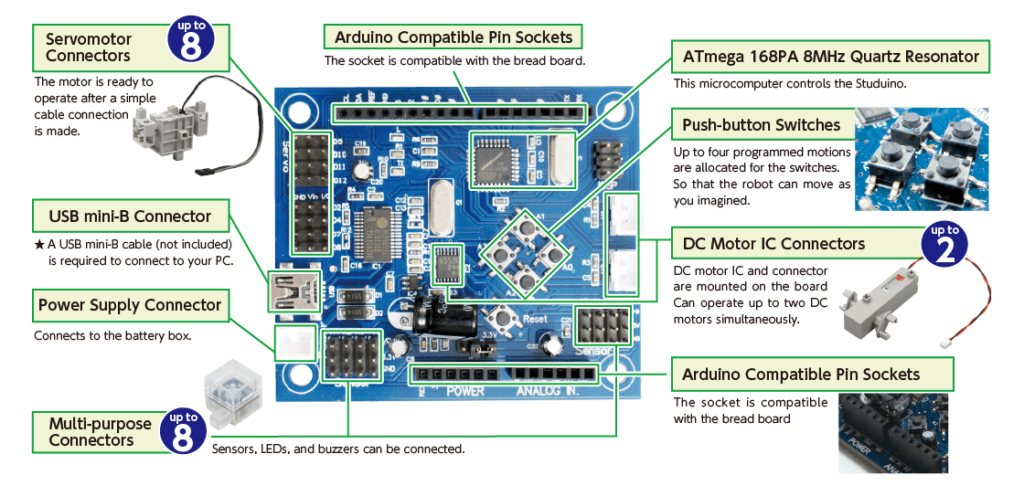
Programming Software Environments
Drag, drop and create
The Icon Programming Environment uses a simple, fun and colorful «drag and drop» interface to let you program your robot.
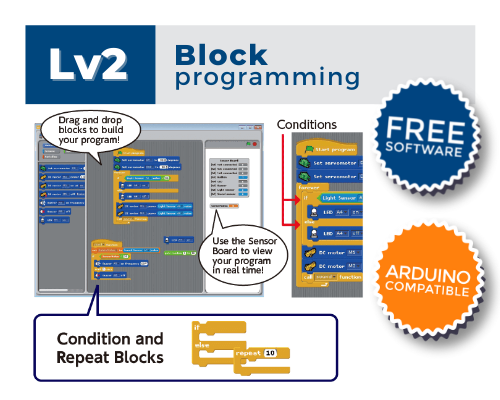
Add Your Heading Text Here
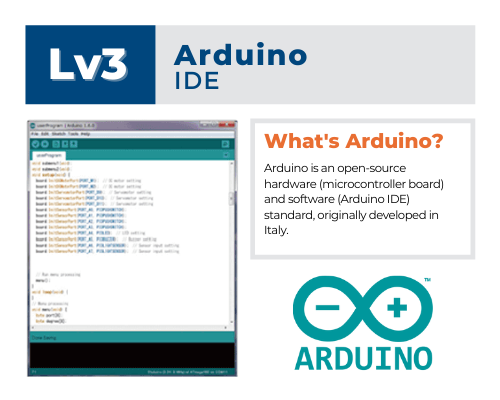
Add Your Heading Text Here
The Arduino IDE is for users ready to tackle advanced programming using the Arduino language. Arduino is compatible with both of the programming environments which allows you to build your program in either one and fine-tune it later.
Teaching Material
Assembly Instructions, Student and Teacher Textbooks
For educators
The ArtecRobo Kits are changing the way students interact and learn about technology, robotics and programming. The structured curriculum and detailed instructions make every part of the learning process more simple, helping educators to better organize their classes time and resources and allowing students to grasp the concepts being taught more easily.
Basic
The Basic Kit comes with 5 assembly examples that explore various sensor functions available; the educator can guide the students to follow the instructions and understand the functions correctly.
Assembly Instructions
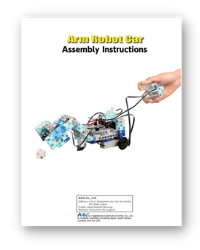
Advanced
The Advanced Kit comes with 9 assembly examples that explore all available components’ functions; the educator can guide the students to follow instructions and understand concepts correctly.
Assembly Instructions
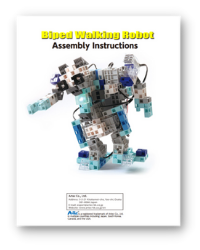
Early Education Set
With six lessons per subject, this set provides a total of 12 lessons covered in 6 textbooks.
Also, this kit includes a teacher’s guide with detailed information and illustrations to easily understand what each component is for, learn how to use the Icon Programming Environment and solve any possible problem.
Robotics:
- – Class 1 (2 lessons): Build a vehicle using a motor and wheels
- – Class 2 (2 lessons): Grab blocks using gears
- – Class 3 (2 lessons): Use various mechanisms for movement
Programming:
- – Class 1 (2 lessons): Program a car to drive
- – Class 2 (2 lessons): Use motors to make a car turn
- – Class 3 (2 lessons): Program sound and light

Education Set
This set covers the basic level of the program, providing 4 textbooks with 4 lessons each that sum up a total of 16 class hours.
It also includes a teacher’s guide with detailed information and illustrations to easily understand how to use components, programming basics and possible errors.
Basic Course:
- – Basic 1 (4 lessons): Building a traffic signal
- – Basic 2 (4 lessons): Making a light show
- – Basic 3 (4 lessons): Making a robot car
- – Basic 4 (4 lessons): Building an automatic door
+ Teacher’s Manual

Education Set Complete Edition
For a more in-depth approach towards Robotics and Programming, this set includes 13 textbooks covering the Basic, Intermediate and Advanced course.
It also includes a teacher’s guide with detailed information and illustrations to easily learn the different components, understand the Block Programming Environment and solve any possible problem.
Basic Course:
- – Basic 1 (4 lessons): Building a traffic signal
- – Basic 2 (4 lessons): Making a light show
- – Basic 3 (4 lessons): Making a self-driving car
- – Basic 4 (4 lessons): Building an automatic door
Intermediate Course:
- – Intermediate 1 (4 lessons): Controlling a line tracer
- – Intermediate 2 (4 lessons): Making an electronic guitar
- – Intermediate 3 (4 lessons): Building an arm robot
- – Intermediate 4 (4 lessons): Machines and mechanisms
- – Intermediate 5 (4 lessons): Creating a video game
Advanced Course:
- – Advanced 1 (4 lessons): Making a battlebot
- – Advanced 2 (4 lessons): Building a walkbot
- – Advanced 3 (4 lessons): Building a scanbot
- – Advanced 4 (4 lessons): Advanced game making
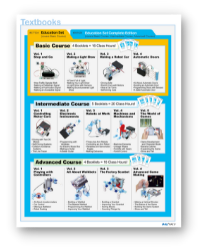
For students
One of the best things about the ArtecRobo Kits is how much freedom it allows. Students can get a real understanding of the concepts being taught, therefore they can dive into creating and programming their own robots, making the learning experience a lot more fun.
Basic
The Basic Kit comes with 5 assembly examples that explore various sensor functions available, providing a starting point towards developing many more robots.
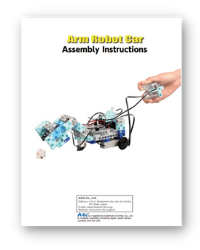
Advanced
The Advanced Kit comes with 9 assembly examples that explore all available functions, providing a starting point towards developing many more robots.
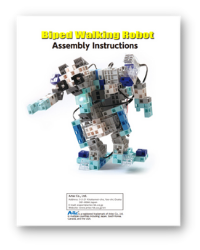
Early Education Set
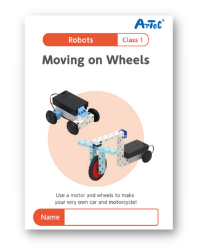
Education Set
The basic course includes 4 booklets with 4 lessons each that sum up a total of 16 lessons. Each guide includes concept explanations and illustrated instructions in order to build a robot and understand how it works.

Education Set Complete Edition
This set includes 13 textbooks covering the Basic, Intermediate and Advanced course. Each textbook provides illustrated lessons with detailed instructions for building the specific lesson’s project and complete the course.

